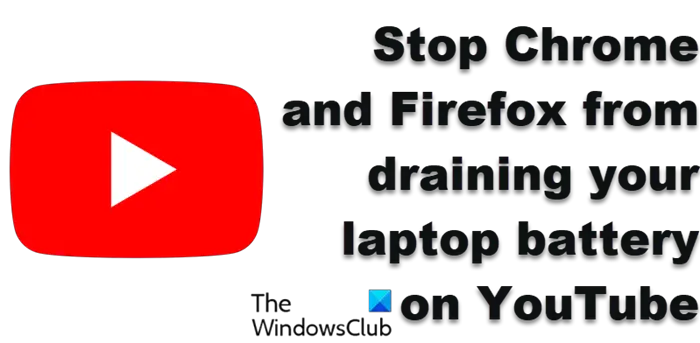You might not know it, but Google Chrome, Firefox, and YouTube are draining the battery life of your Windows laptop. You should notice this whenever YouTube begins to stutter, or when your system heats up along with kicking the fan into a new gear.

Why viewing YouTube videos on Firefox or Chrome drains battery?
This happens mainly when using Chrome or Firefox, and less so with Microsoft Edge and Internet Explorer. This issue with Firefox and Chrome is probably even more of a problem on Macs, but we won’t dig into that today.
The stuttering and the battery performance issues, all have a single enemy, and that is YouTube’s switch to HTML5 for video playback. Google has rid YouTube of Flash, but by doing so, it is got rid of the H.264 media codec that was seen as the industry standard.
Stop Chrome and Firefox from draining your laptop battery on YouTube
Neither Google or Mozilla wants to support H.264 because it has a lot of patents behind it. To use it, these companies must pay the patent holders, and they wish to stop this from happening.
Firefox, for a long time, did not support H,264, but had to bow under pressure this year.
To end the dominance of H.264, Google acquired a new media codec called VP8. It is free for anyone to use, but despite that, the codec failed to gain much traction, although Firefox is currently a supporter.
Failure of VP8 did not detract Google, as the company chose to create VP9 with the promise that it would end support for H.264, but so far, it was all talk because up to this point, Chrome still supports the codec.
Also, when playing videos on YouTube, both Chrome and Firefox switches to the VP9 and leaves H.264 for dead.
It all boils down to hardware acceleration, ladies and gentlemen. Using the GPU to offload the majority of the work makes for smoother computer performance. The problem is; hardware acceleration is only supported by H.264 while VP9 relies a lot on the CPU to give it the boost it needs.
Many companies such as AMD and NVidia have promised to support VP9 where this is concerned, but after 5-years, nothing has happened yet.
This leaves computer users to dabble through their options. They can simply switch to Microsoft Edge and Internet Explorer because those browsers do not support VP9, and as such, video playback on YouTube and most other websites should be painless due to hardware acceleration. However, switching to those browsers might be a tough ask.
Use h264ify plugin
The next option is to download a plugin for both Chrome and Firefox that is called h264ify. This plugin forces Firefox and Chrome to request H.264 from YouTube. Going this route should fix battery life issues, among others, but we can’t be sure for sure how long h264ify will be supported.
If we were you, we’d go with h264ify. It works, and we saw a difference in video performance almost instantly.